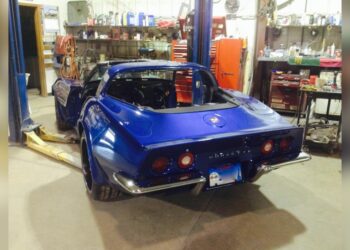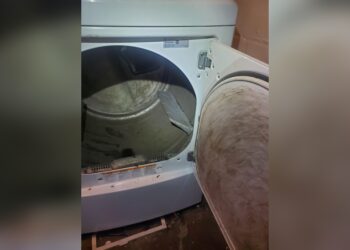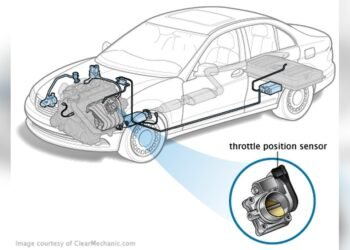Turbos can reach temperatures up to 800°C (1472°F) due to the high heat generated by the exhaust gases passing through them. This extreme heat is a result of the turbocharger’s function in compressing air for combustion in the engine.
Turbochargers are essential components in modern engines, providing a significant boost in power and performance. However, their operation involves intense heat that can reach extreme levels. The question arises: how hot do turbos actually get? Understanding the temperature range of turbos is crucial for maintaining their optimal performance and preventing any potential damage.
We will delve into the topic and explore the temperatures turbos can reach, the factors that influence their heat generation, and how it affects the overall engine performance. So, let’s dive in and uncover the hot world of turbos.
The Role Of Heat In Turbo Performance
The intense heat generated by turbochargers can reach temperatures exceeding 800°C, crucial for optimal performance. Understanding how hot turbos get is essential for ensuring engine efficiency and longevity. Proper maintenance and monitoring are key to managing turbo heat effectively.
Turbo Dynamics: The Temperature Spectrum
Understanding the temperature spectrum within a turbocharger is crucial for optimizing its performance. Turbochargers operate under extreme conditions, generating both high heat and high pressure to boost engine power. The temperature range within a turbo can vary significantly depending on various factors such as engine load, exhaust gas flow, and turbo size.
At the heart of a turbocharger lies the turbine housing, where exhaust gases pass through to drive the turbine wheel. This area can reach temperatures of up to 800°C (1472°F) during peak engine operation. On the other side, the compressor housing, which compresses the intake air, can reach temperatures of around 100-200°C (212-392°F). These extreme temperatures highlight the importance of heat management within a turbocharger.
Heat Management: Protecting Turbo Integrity
Efficient heat management is crucial for ensuring the longevity and performance of a turbocharger. Excessive heat can lead to various issues such as thermal degradation, oil coking, and component failure. To mitigate these risks, turbochargers are designed with a range of heat management features.
One such feature is the use of heat shields or heat blankets. These insulating materials help to reduce heat transfer to surrounding components, minimizing the risk of damage or excessive heat buildup. Additionally, turbochargers are often equipped with oil and water cooling systems to regulate temperatures and prevent overheating.
It’s important to note that proper heat management goes beyond just the turbocharger itself. The entire engine system, including the exhaust and intake components, must be optimized to dissipate heat effectively. This can include the use of heat-resistant materials, improved airflow, and efficient cooling systems.
Understanding the role of heat in turbo performance is essential for maximizing engine power and ensuring the longevity of the turbocharger. By managing heat effectively and implementing proper heat management strategies, turbochargers can operate within their optimal temperature range, enhancing overall engine performance.
Turbo Temperature Basics
Discovering Turbo Temperature Basics involves understanding how hot turbos get during operation. Turbo housings can reach high temperatures, with the exhaust side hitting up to 800°C. Proper sizing and maintenance are crucial to prevent overheating issues and ensure optimal turbo performance.
Maximizing Efficiency: Ideal Operating Temperatures
Turbos operate best within specific temperature ranges to maximize efficiency.
Risks Of Excessive Heat
Excessive heat can lead to turbo damage and reduced performance.
Understanding turbo temperatures is crucial for optimal performance.
- Normal Range: Turbo temperatures typically range from 900°F to 1600°F.
- Ideal Operating Range: Ideal temperatures fall between 1200°F and 1400°F for peak efficiency.
- Boost Levels: Higher boost levels increase turbo temperatures.
- Fuel Quality: Poor-quality fuel can lead to higher operating temperatures.
- Engine Load: Heavy loads can raise turbo temperatures significantly.
- Turbine Damage: Excessive heat can cause turbine components to warp or crack.
- Reduced Efficiency: High temperatures can reduce overall turbo efficiency.
- Oil Degradation: Extreme heat can degrade the oil, leading to lubrication issues.
- Proper Maintenance: Regular maintenance can help prevent overheating.
- Cooling Systems: Efficient cooling systems are essential for managing turbo temperatures.
- Monitoring: Regularly monitoring turbo temperatures can help detect issues early.
Measuring The Heat
Turbos are known to generate substantial heat during operation, and monitoring their temperatures is crucial for ensuring optimal performance and longevity. Measuring the heat of turbos involves using specialized tools and techniques to gauge the intense temperatures they can reach.
Tools And Techniques For Temperature Monitoring
When it comes to monitoring the temperatures of turbos, a variety of tools and techniques are employed to accurately measure the heat they produce. Some common tools and techniques include:
- Infrared Thermometers
- Thermocouples
- Exhaust Gas Temperature (EGT) Sensors
- Pyrometers
- Heat-Sensitive Paints and Coatings
Real-world Data: Average Temperatures Recorded
Real-world data provides valuable insights into the average temperatures recorded in various turbo applications. The following table showcases average temperatures observed in different parts of a turbo system:
| Turbo Component | Average Temperature (°C) |
|---|---|
| Turbocharger Housing | 600-800°C |
| Turbo Manifold | 800-1000°C |
| Exhaust Gas Temperature (EGT) | 650-900°C |
Components In The Hot Seat
Turbos can reach temperatures exceeding 1000°F, especially under heavy load or high boost conditions. The intense heat affects various components in the turbo system, including the housing, exhaust side, and the air coming out of the turbo. Understanding how hot turbos get is crucial for optimizing their performance and preventing overheating issues.
The Exhaust Side: A Closer Look
When it comes to turbochargers, the exhaust side is where all the action happens. This is the component that experiences the highest temperatures and faces the most intense heat. Understanding how hot the exhaust side of a turbo can get is crucial for both turbocharger manufacturers and enthusiasts.
The exhaust gases produced by the engine are directed towards the turbine wheel of the turbocharger. As these gases pass through the exhaust housing, they transfer their heat energy to the turbine wheel, causing it to spin rapidly. This process generates immense heat, with temperatures reaching up to 800°C in some cases.
Such extreme temperatures can have a significant impact on the performance and longevity of the turbocharger. The high heat can cause the turbine housing to expand, potentially leading to cracking or warping. Additionally, the intense heat can also affect the lubrication system and the oil that flows through the turbo, as well as the surrounding components in the engine bay.
The Cooler Side: Temperatures And Effects
While the exhaust side of the turbocharger gets scorching hot, the cooler side, also known as the compressor side, deals with a different set of temperatures. As the compressed air passes through the intercooler, it cools down significantly before entering the engine.
The intercooler plays a crucial role in reducing the temperature of the compressed air. It ensures that the cooler and denser air is supplied to the engine, improving combustion efficiency and overall performance. The temperatures on the cooler side can vary depending on various factors, but they typically range from 40°C to 80°C.
It’s important to note that the temperature difference between the exhaust side and the cooler side is substantial. This temperature differential creates a challenging environment for the turbocharger, as it constantly transitions between extreme heat and relatively cooler temperatures.
To mitigate the effects of high temperatures, turbochargers are designed with heat-resistant materials and advanced cooling systems. Heat shields, turbo blankets, and water-cooled systems are some of the measures employed to protect the turbocharger and surrounding components from excessive heat.
In conclusion, turbochargers operate in a demanding environment, with the exhaust side experiencing temperatures as high as 800°C. The intense heat can impact the turbo’s performance, longevity, and surrounding components. However, with proper design and cooling mechanisms, turbochargers can withstand these extreme temperatures and provide the desired boost to the engine.
Impact Of Heat On Turbo Lifespan
The heat generated by a turbocharger can significantly impact its lifespan. Understanding the thermal wear and tear, as well as effective cooling methods, is crucial for maintaining the longevity and performance of a turbo.
Thermal Wear And Tear
Turbochargers operate at extremely high temperatures, reaching up to 800°C. This intense heat causes thermal stress on turbo components and can lead to premature wear and deterioration. It’s essential to recognize that excessive heat can impact the durability and reliability of a turbocharger over time.
Cooling Down: Methods And Myths
- Cooling a turbocharger after high-speed driving is crucial to prevent overheating and prolong its lifespan.
- Myths about cooling methods may lead to ineffective practices. Proper cooling techniques, such as allowing the engine to idle for a few minutes, can help reduce the temperature of the turbocharger.
- Utilizing a turbo blanket can also aid in thermal management by insulating the turbo and minimizing heat transfer to the engine bay.
Heat-induced Failures
Turbos can reach temperatures as high as 800°C, causing heat-induced failures if not managed properly. It’s crucial to understand the extreme heat levels turbos can withstand to prevent potential damage and ensure optimal performance. Regular maintenance and monitoring are essential to avoid overheating and related issues.
When Turbos Overheat: Symptoms And Consequences
When turbos overheat, they exhibit specific symptoms and consequences that can be detrimental to both the turbo itself and the overall performance of the engine. The excessive heat can lead to a variety of issues, ranging from reduced efficiency to catastrophic failure.
Red Alert: The Glow Of An Overstressed Turbo
One unmistakable sign of an overstressed turbo is the ominous glow that emanates from it when it reaches extreme temperatures. This red glow is a clear indication that the turbo is operating well beyond its designed limits and is at risk of imminent failure.
After The Heat: Turbo Cool-down Practices
Turbochargers can reach temperatures as high as 800°C, making it crucial to implement effective turbo cool-down practices. Proper cool-down procedures help prevent damage to the turbo and ensure its longevity. By allowing the turbo to cool down gradually after driving, you can avoid potential issues caused by excessive heat.
The Importance Of Cooling Down Post-drive
After the intense heat generated during operation, it is crucial to allow the turbo to cool down properly. This helps prevent damage and prolongs its lifespan.Practical Tips For Turbo Maintenance
1. Avoid sudden stops: After driving, let the engine run at idle for a few minutes to allow the turbo to cool gradually. 2. Use quality oil: Ensure regular oil changes with high-quality oil suitable for turbocharged engines. 3. Monitor exhaust temperature: Invest in a gauge to keep track of exhaust temperature and prevent overheating. 4. Install a turbo timer: Consider installing a turbo timer to allow the engine to idle for a set time after driving. 5. Regular inspections: Check for leaks, cracks, or other signs of wear on the turbo components regularly. By following these maintenance practices, you can ensure your turbo stays in optimal condition for longer.Thermal Solutions And Upgrades
When it comes to managing the intense heat generated by turbochargers, thermal solutions and upgrades play a crucial role in enhancing performance and longevity. From turbo blankets to advanced cooling systems, there are various options available to keep turbos running optimally.
Turbo Blankets And Heat Shields: A Review
Turbo blankets are designed to contain the heat within the turbocharger housing, reducing heat transfer to surrounding components. Heat shields act as a barrier, protecting sensitive parts from high temperatures. Both solutions help improve overall efficiency and prevent heat-related issues.
Advanced Cooling Systems For Enhanced Performance
Upgrading to advanced cooling systems such as water-methanol injection or upgraded intercoolers can significantly lower temperatures and improve turbocharger performance. These systems work by reducing intake air temperatures, resulting in denser air for combustion and increased power output.
Frequently Asked Questions
How Hot Are Turbos?
Turbos can reach temperatures up to 800°C due to the high-speed exhaust gases.
How Hot Do Turbo Housings Get?
Turbo housings can get as hot as 800°C during operation, which is crucial for optimal performance.
What Is The Heat Temperature Of A Turbo?
The heat temperature of a turbo can reach up to 800°C.
How Hot Does A Turbo Manifold Get?
A turbo manifold can get extremely hot, typically reaching temperatures of 1,200 to 1,800 degrees Fahrenheit. The exact temperature depends on various factors, such as the type of turbo, the boost level, and the type of fuel being used. It is important to use high-quality materials and proper insulation to prevent damage and ensure optimal performance.
How Hot Can A Turbo Get?
Turbo temperatures can reach up to 1,800°F or 982°C during high boost conditions.
Conclusion
Turbos can get extremely hot, with temperatures reaching up to 800°C. The heat generated by the turbo can cause damage to surrounding components, making it important to use proper cooling methods. Understanding how hot a turbo can get is crucial in ensuring its longevity and optimal performance.
Proper maintenance and monitoring of turbo temperatures can help prevent any potential damage and keep your engine running smoothly.
















